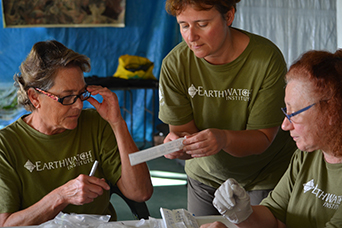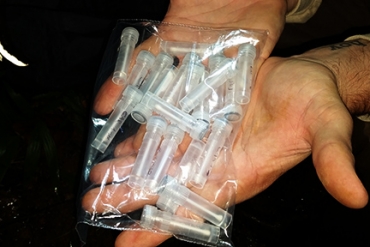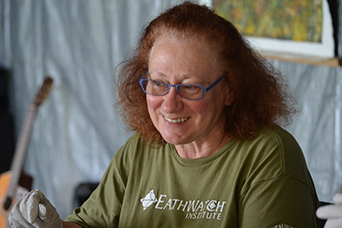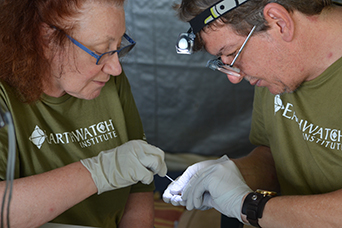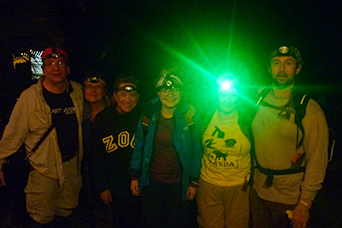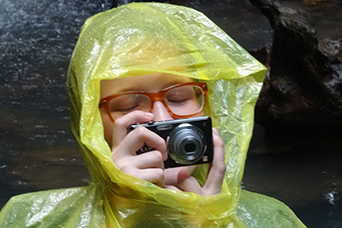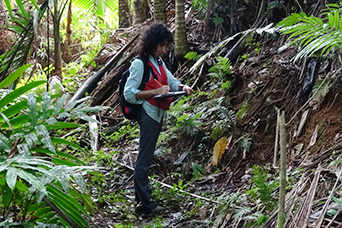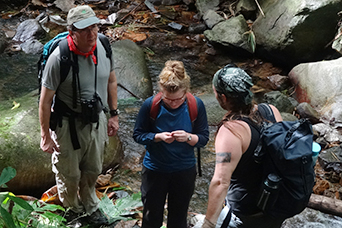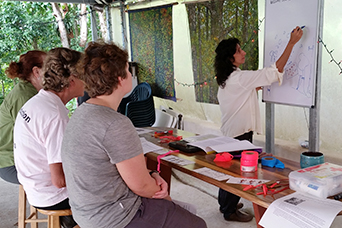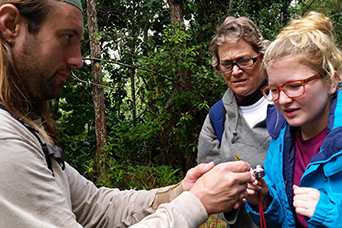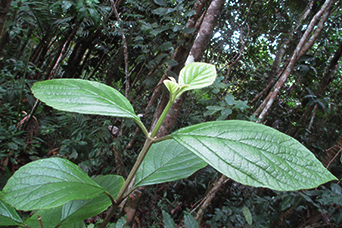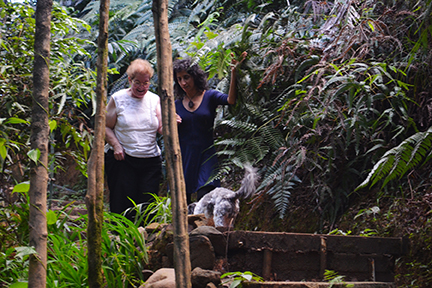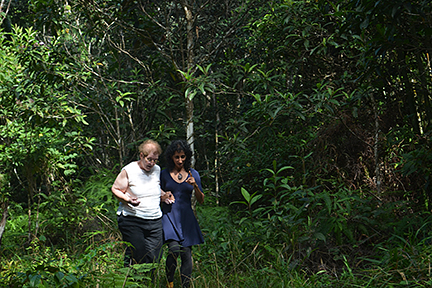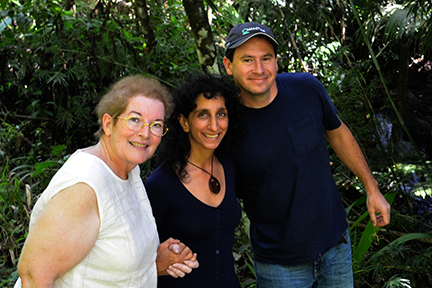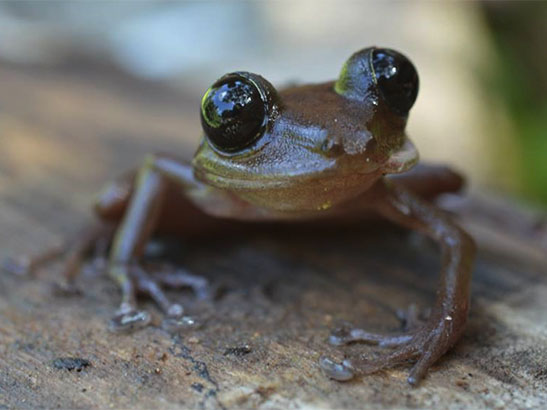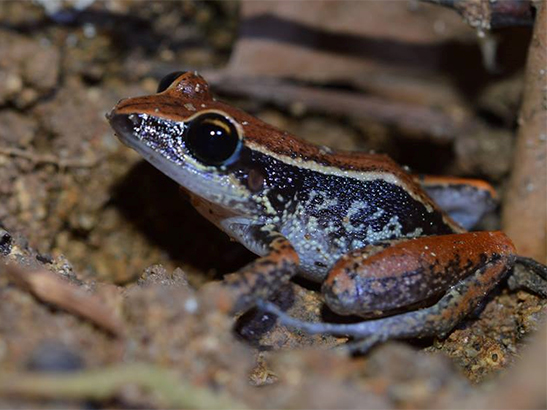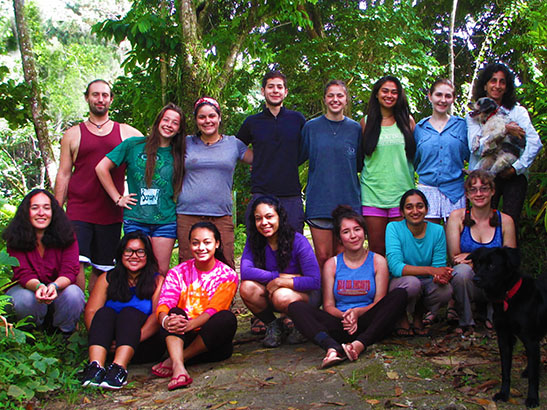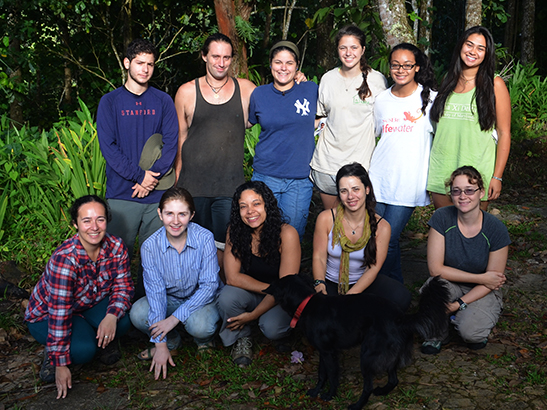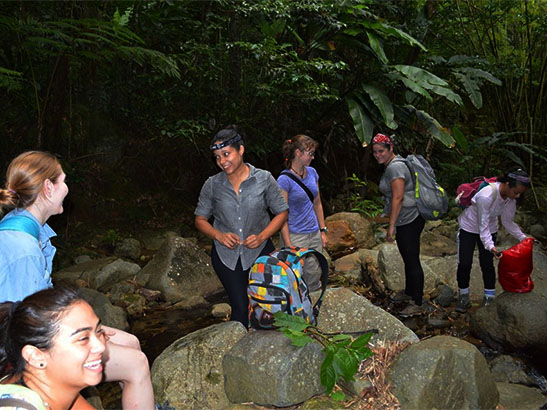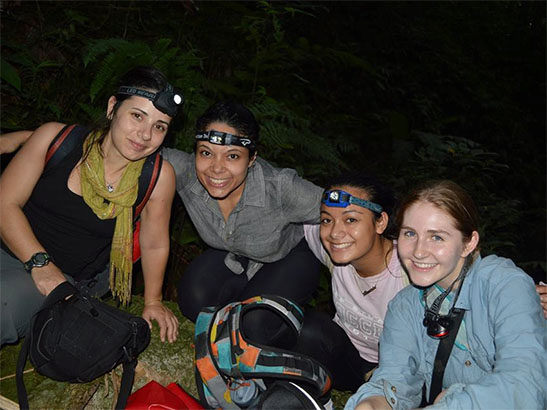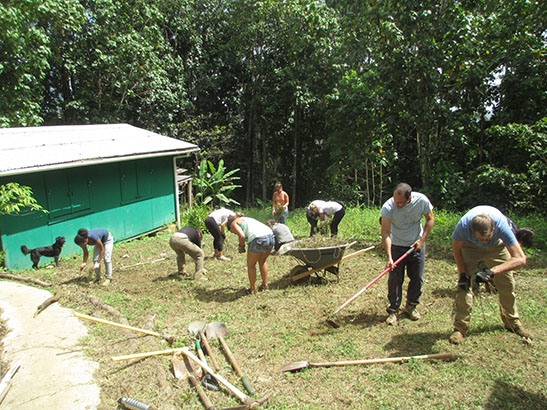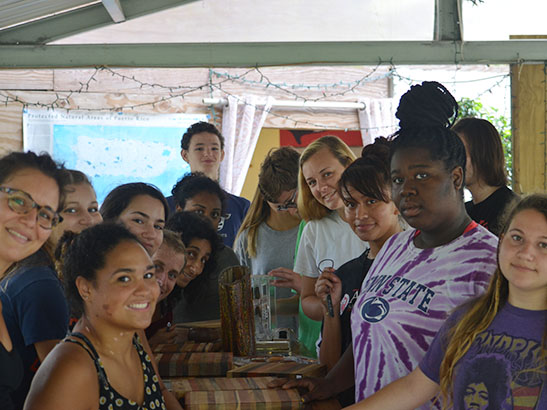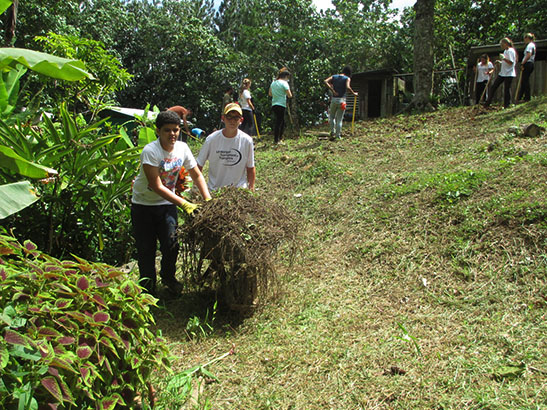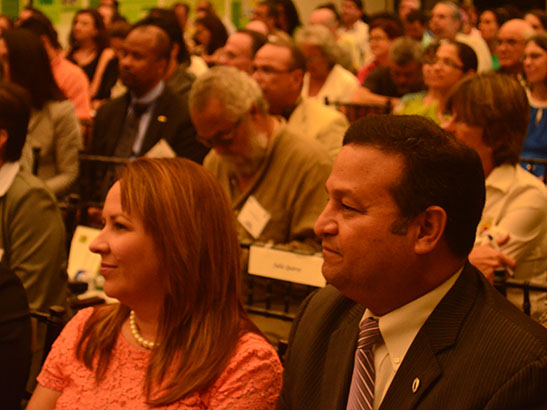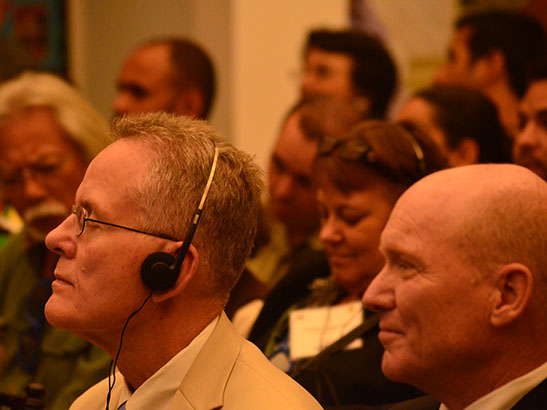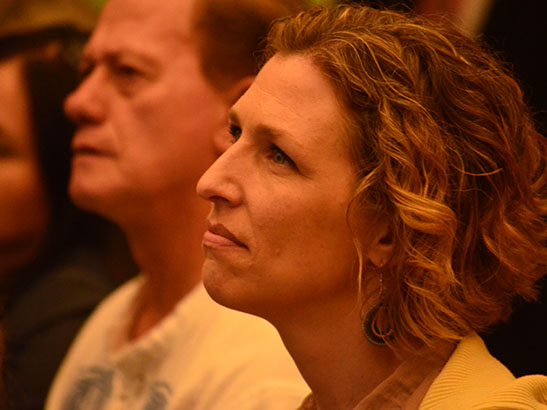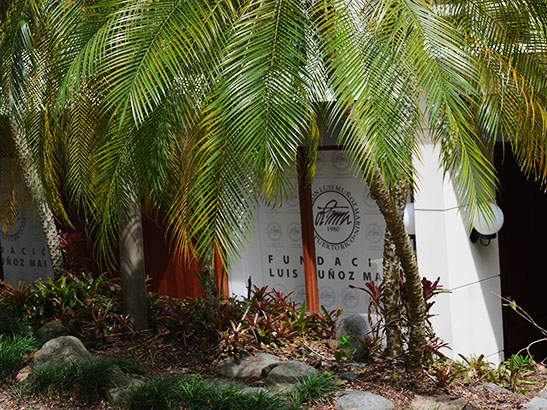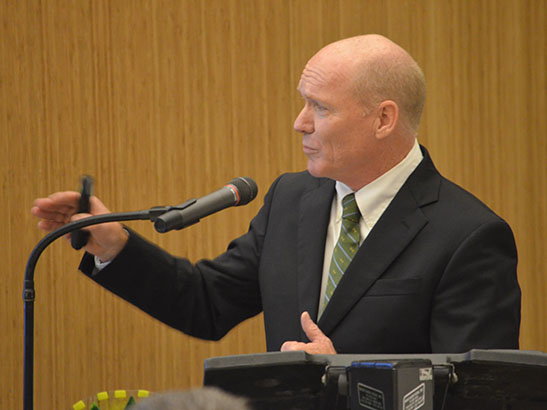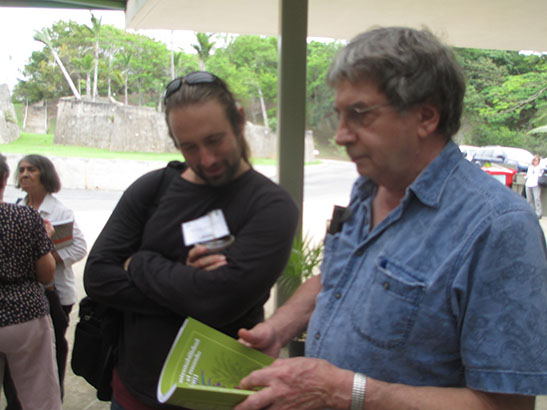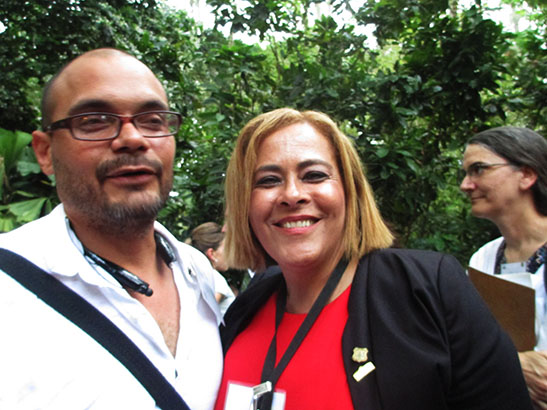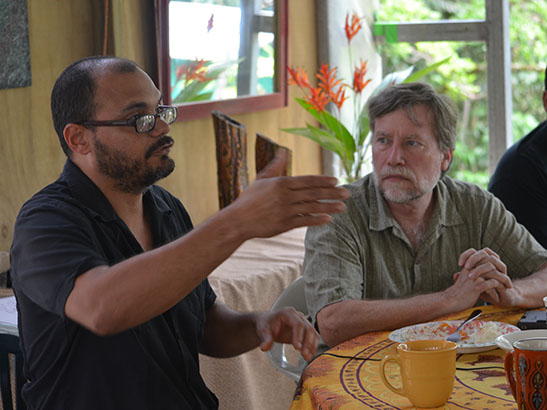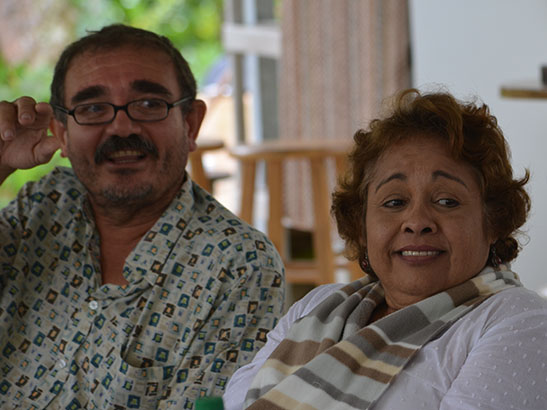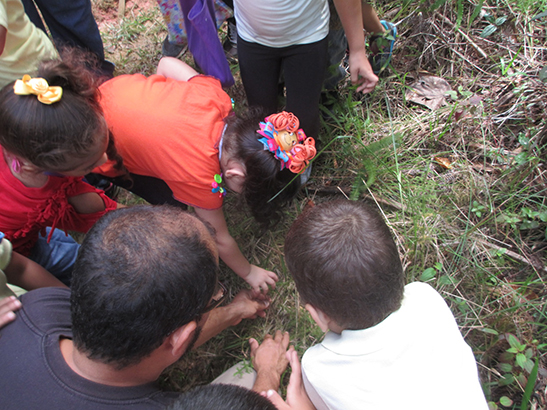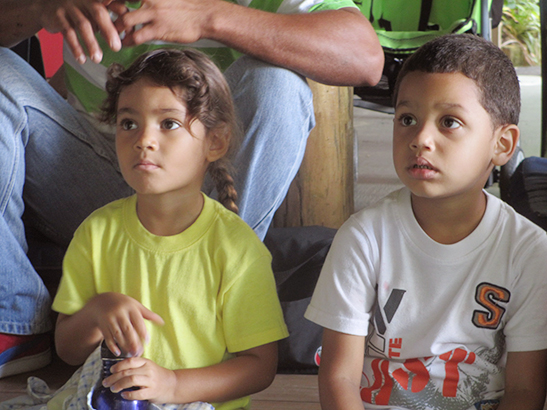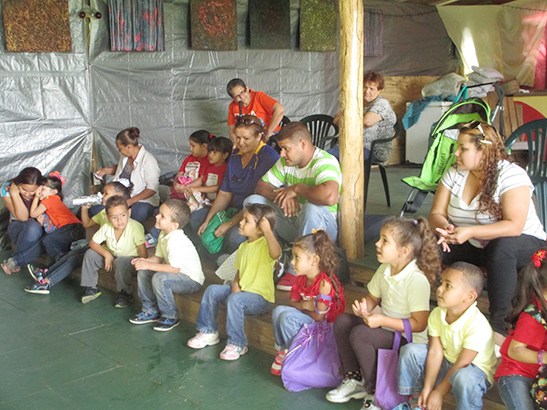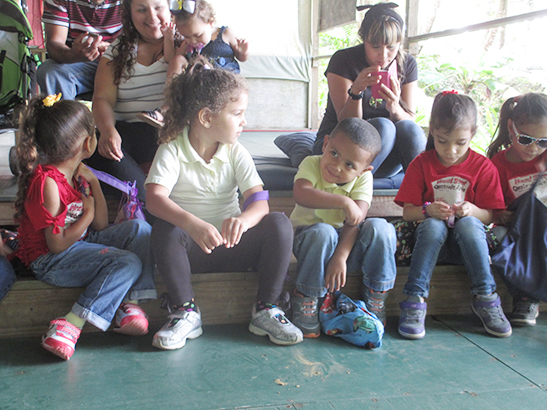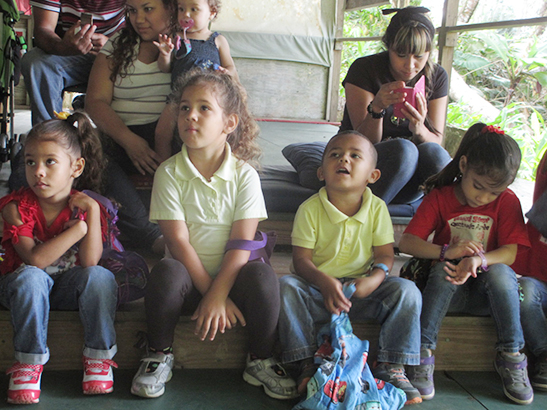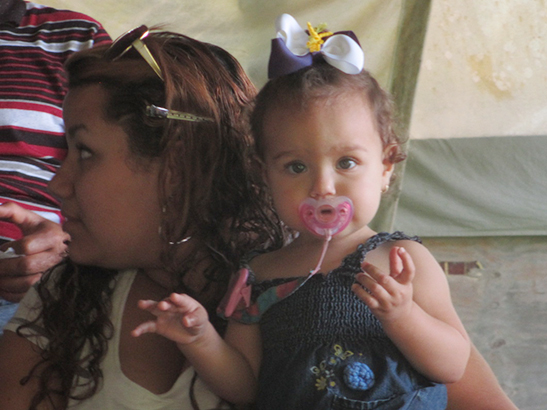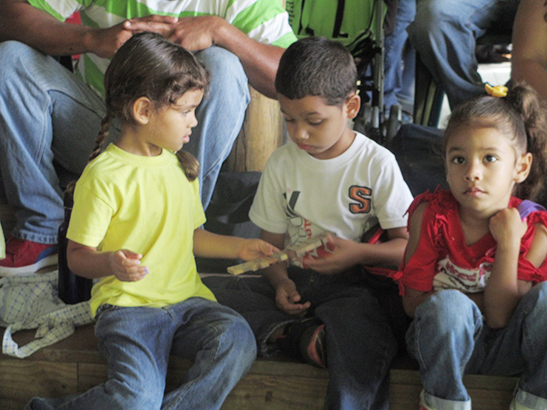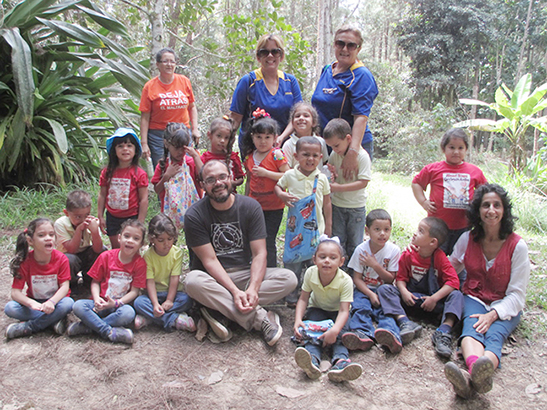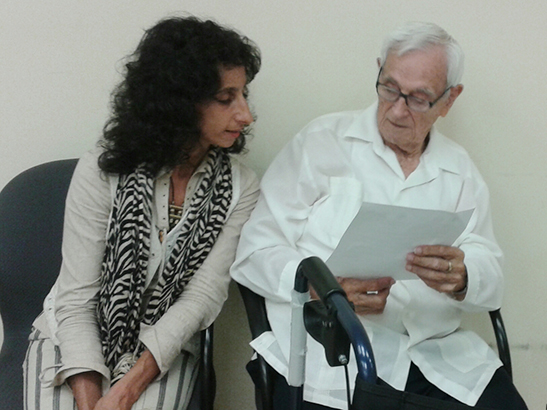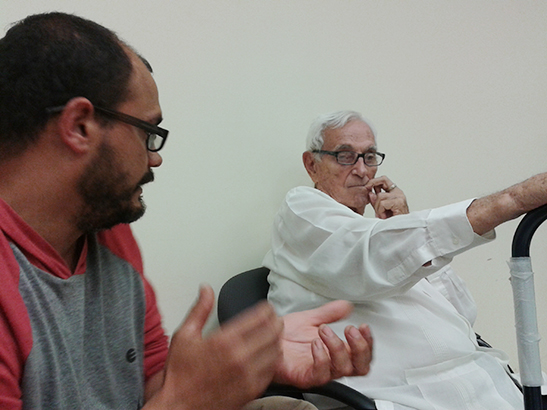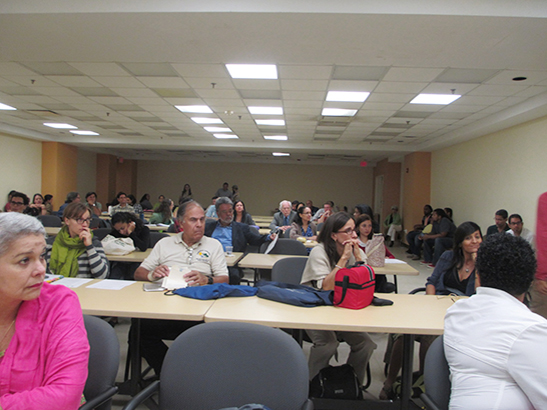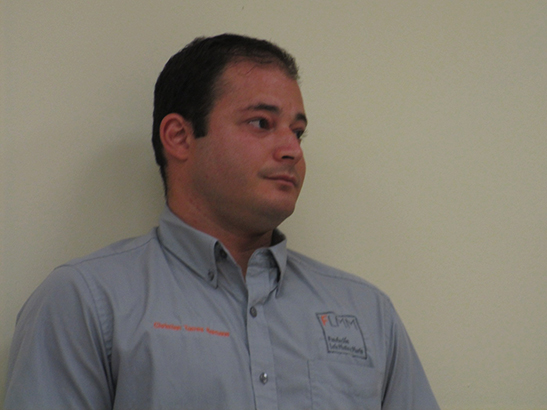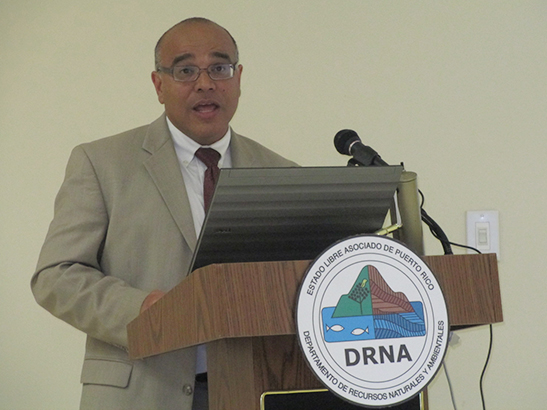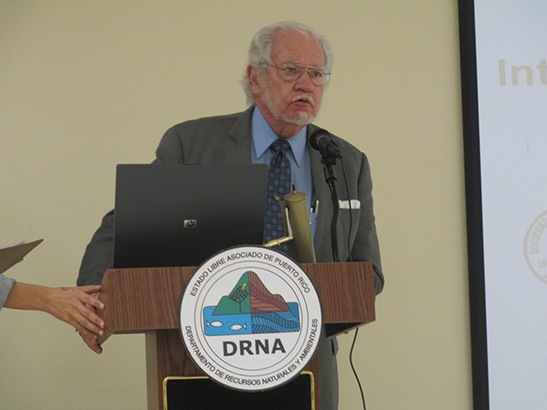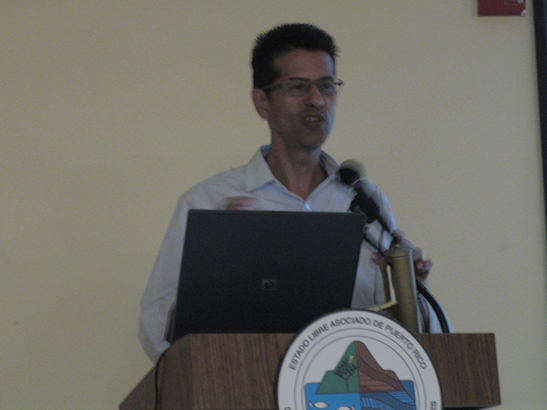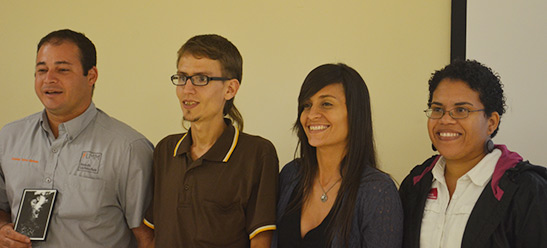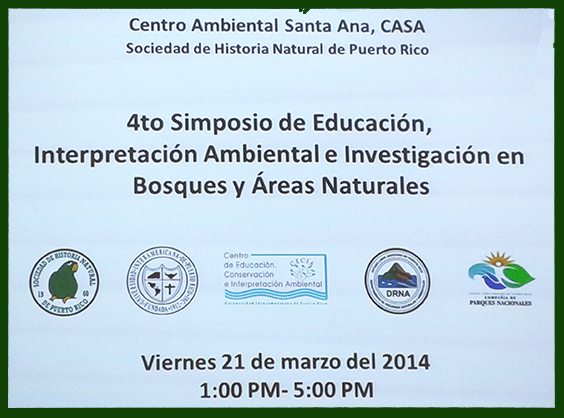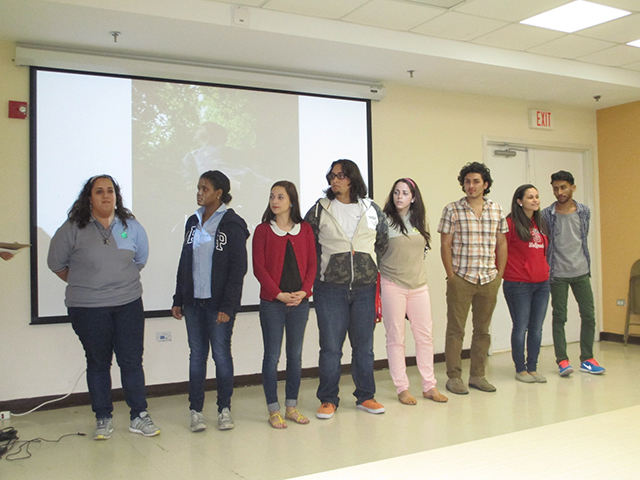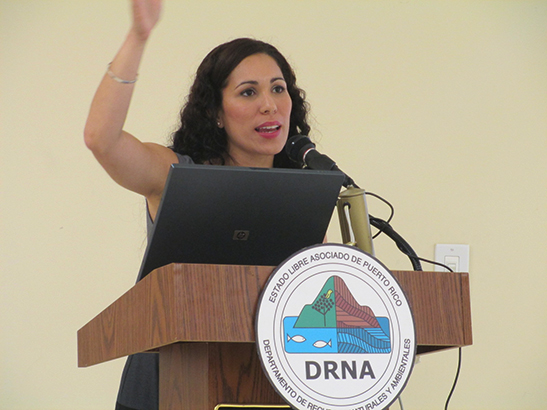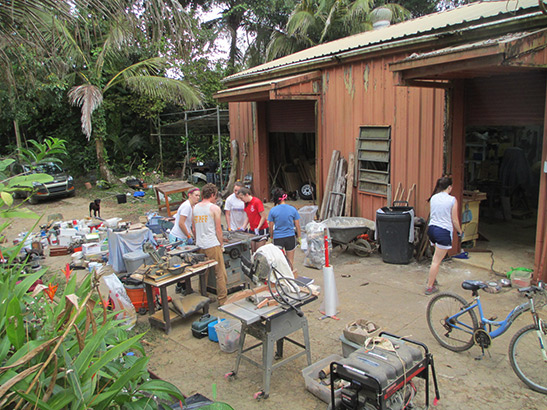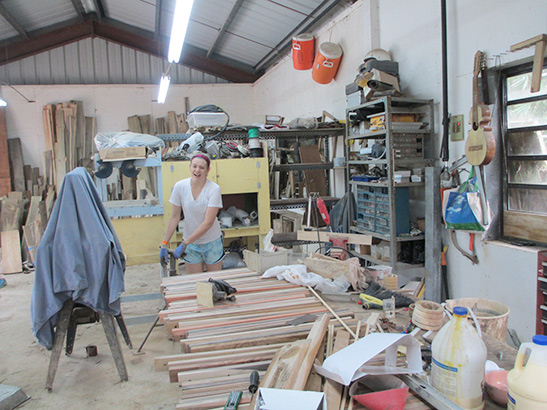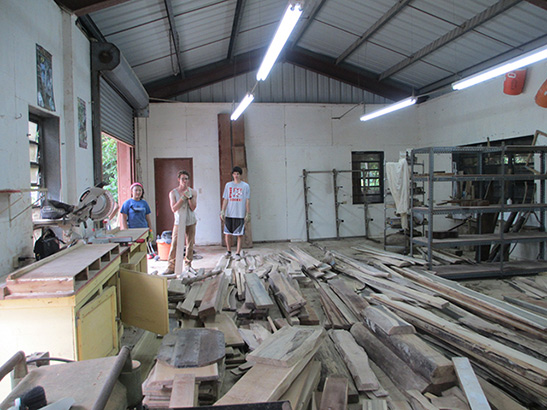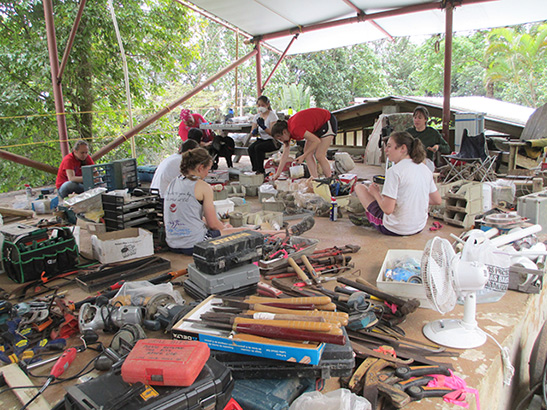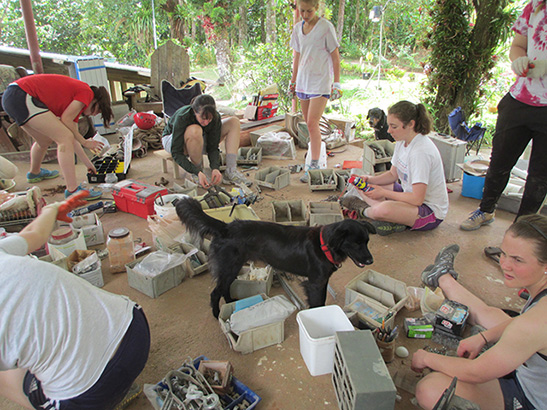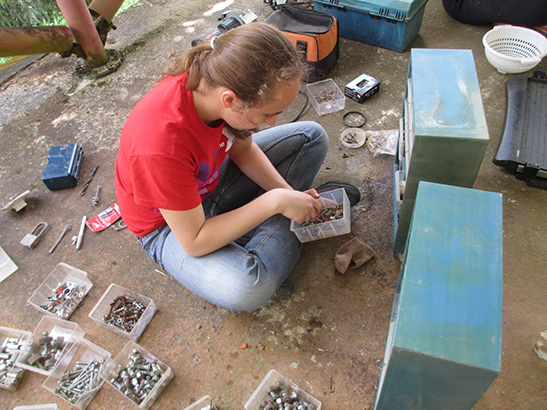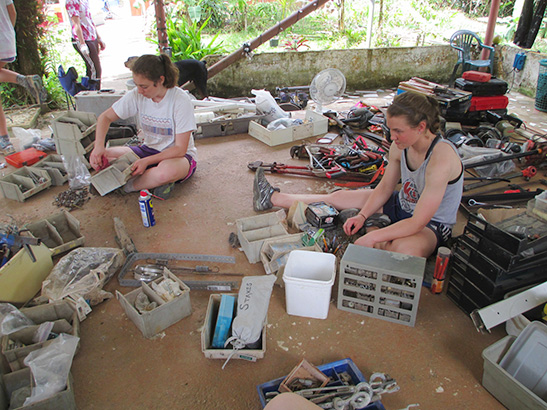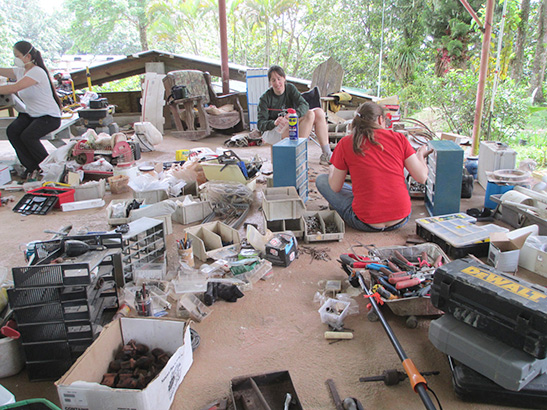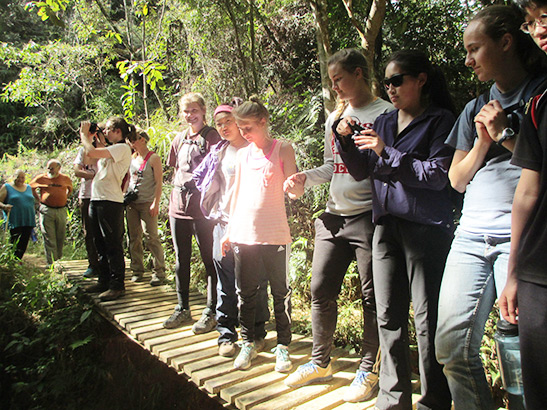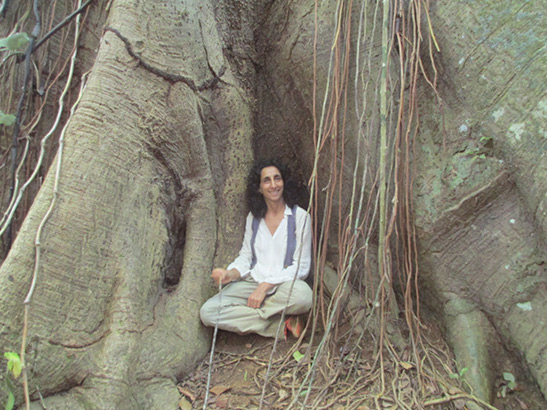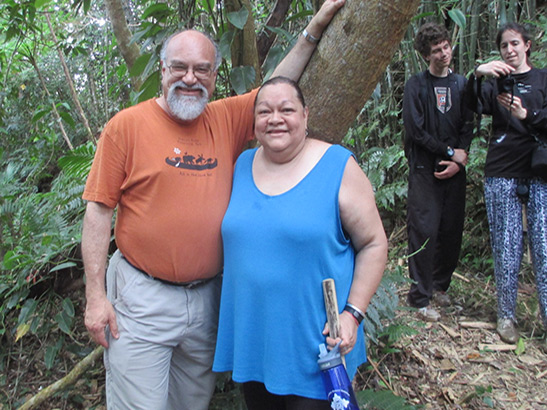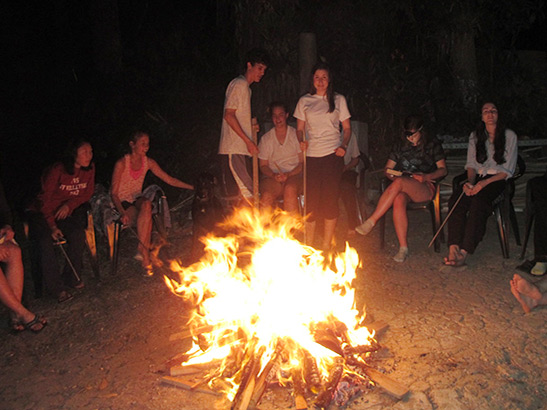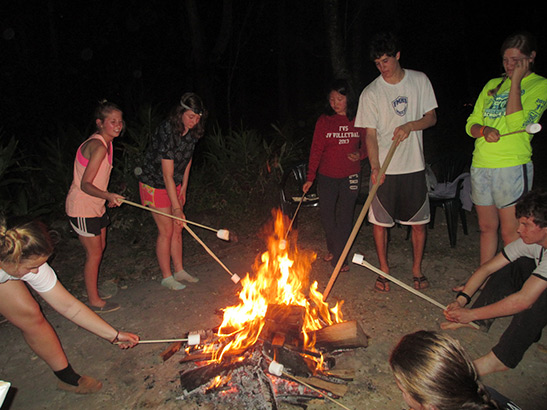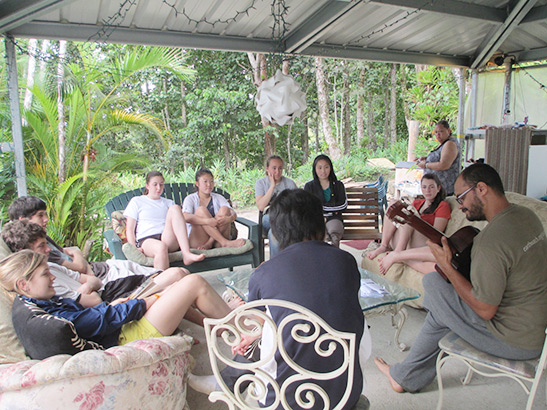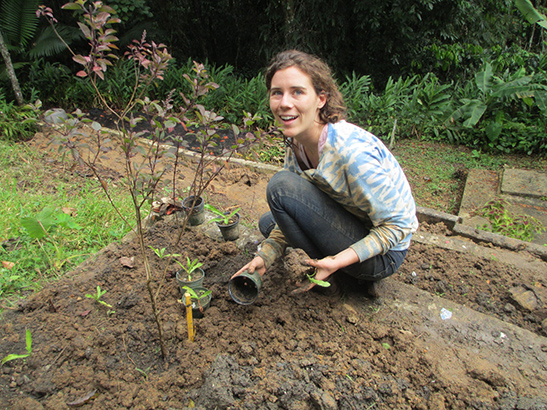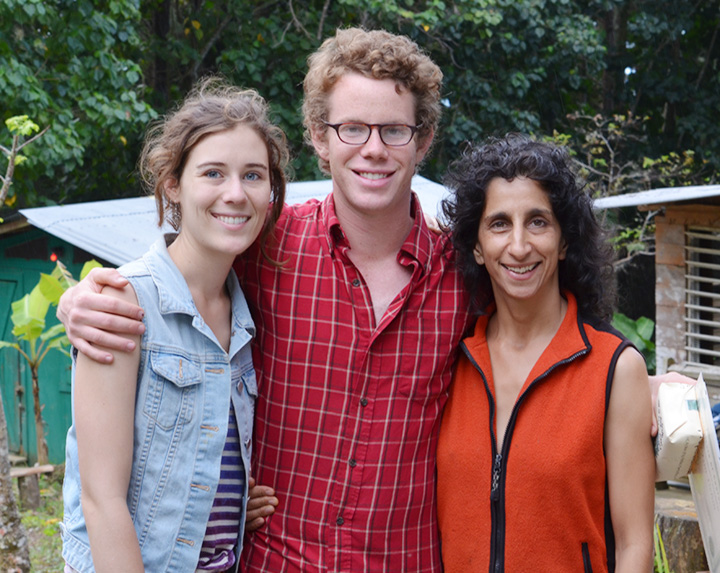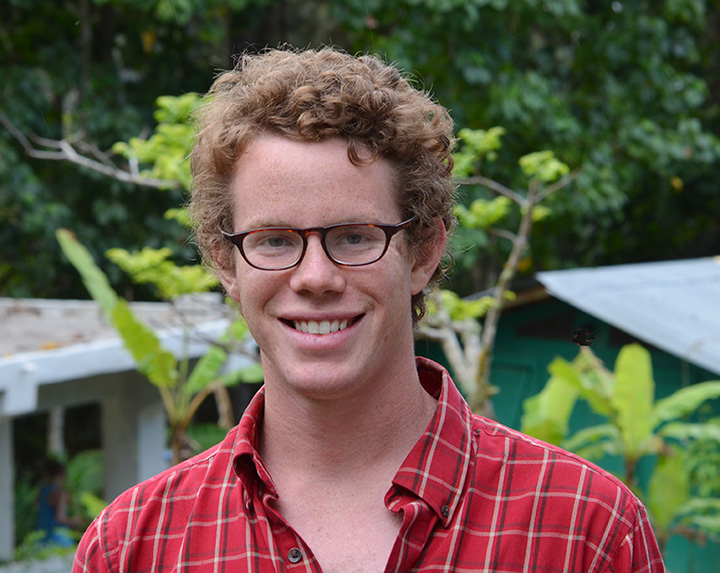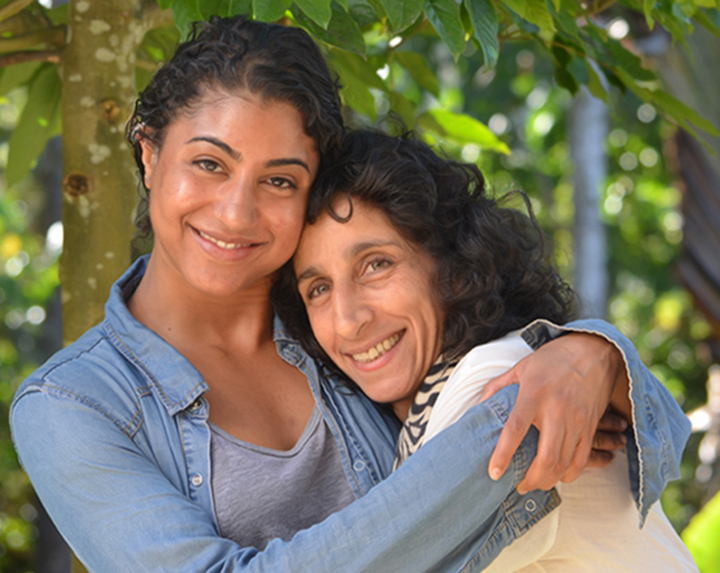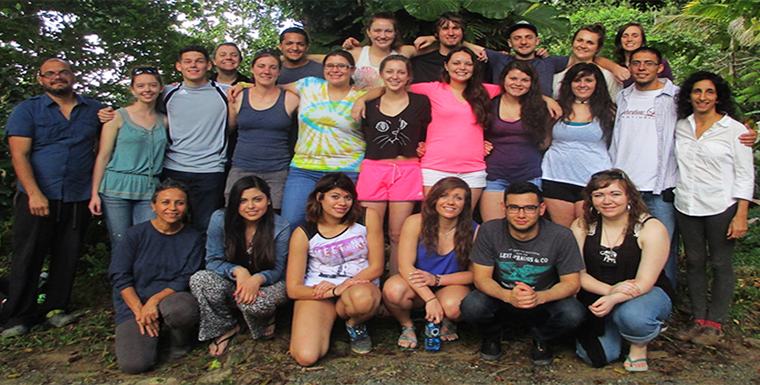

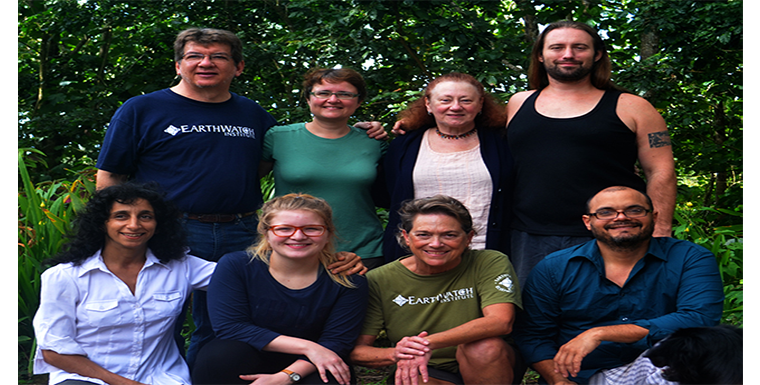
Back L-R: Stan Rullman Cindy Stieger, Margaret Baisley, PI Norman Greenhawk
Front L-R: PI 3t Vakil, Charlotte Field, Colleen Casey, Andrés Rúa
All pix on this page thanks to all above.
See Stan’s Blog about this trip!
https://earthwatchunlocked.wordpress.com/2015/04/30/from-trees-to-coquis-an-earthwatch-scientist-explores-puerto-ricos-rainforest/ 2015
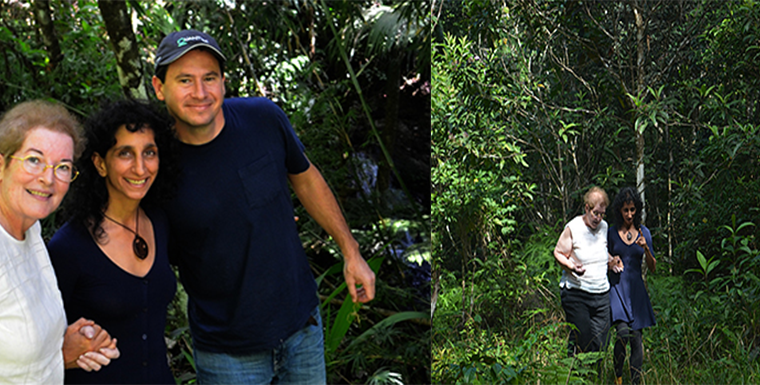
Hilda Soltero was the Secretary of The Puerto Rico Department of Natural Resources in the early 1980s, and it was she that flew John Allen over the island when he was looking for a place to start a sustainable forestry project. Dr. Mark Nelson and John Rubio Druitt met with Dr. Frank Wadsworth in 1983 to discuss the possibilities. In 1983, Las Casas de la Selva was born. Today in December 2014, we shared with Hilda great discussions, stories, visions and plans, and enjoyed the company of her two sons and four grand kids. Thank you Hilda for your continuing support of tropical forestry, along with this project here in Patillas, and look forward to working with you on the mission of sustainable forestry in Puerto Rico.
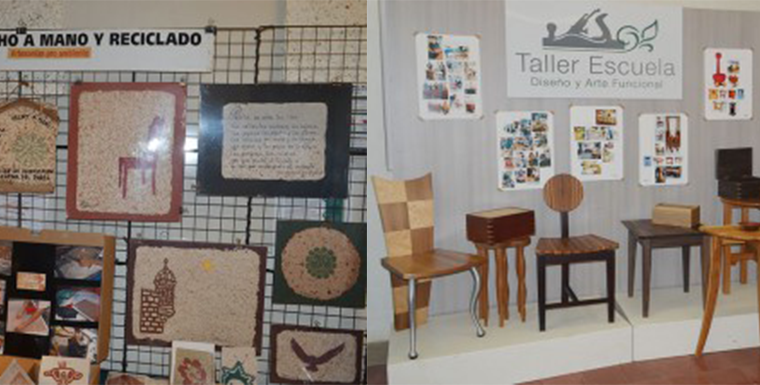
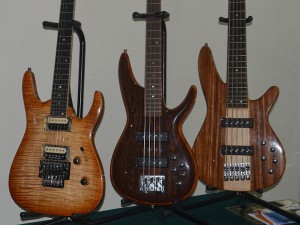
SEE MORE IMAGES HERE:
https://plus.google.com/photos/114745085458651133282/albums/6089798854434161681?authkey=CLytzaWvsMmIfg
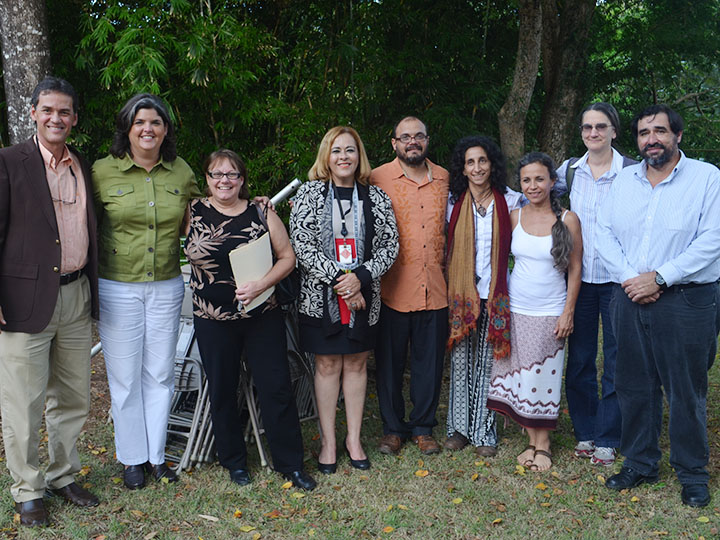
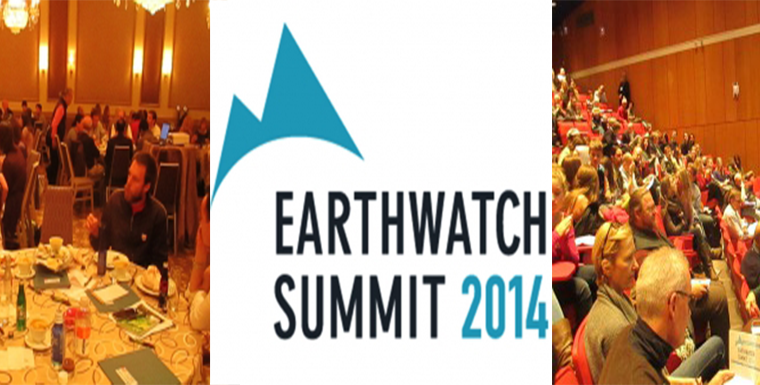
Earthwatch Summit October 2014 Pix by 3t https://t.co/W9FwlZisif pic.twitter.com/KcEP9cYjZk
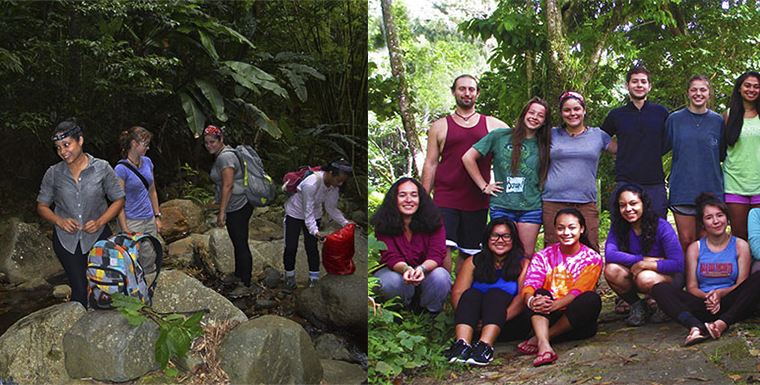
HERPETOLOGICAL EXPEDITION JULY-AUGUST 2014
The steep and remote areas of Icaco and Hormiga Valleys of Las Casas de la Selva have never been surveyed for amphibians. Herpetologist Norman Greenhawk led a team of volunteers into the forest to search for target species of frogs in this vast area, to identify and gather information about amphibians to better assist with the future management of this area. The expedition started on 16th July, and continued to 8th August 2014. The team set up camp in the forest, prepared their own food, and faced some days of extremely challenging windy and rainy weather, including an interruption of the study by Tropical Storm Bertha! The team included college students from the continental US, Puerto Rico, an Earthwatch Teen Team, and Dr. Gabriela Agostini from Argentina. They and came back with a lot of data.
The target species that were confirmed to exist in the valleys were: IUCN Endangered Eleutherodactylus wightmanae (the Coqui Melodioso), IUCN Vulnerable Eleutherodactylus cooki (Coqui Guajon), and IUCN Critically endangered Eleutherodactylus richmondi (Coqui Caoba).
During the surveys, the team sampled for Chytridiomycosis, an infectious disease of amphibians, caused by the chytrid Batrachochytrium dendrobatidis, a non-hyphal zoosporic fungus, that is currently killing off amphibians around the world. GPS co-ordinates of appropriate information were taken to allow for mapping of the range of target species within the valley, and high quality photos of the frogs were taken to help show the myriad variation of colors and patterns within a single species.
The initial survey is over and the data is being compiled. Norman has met with personnel of the US Fish and Wildlife Service to help determine future monitoring and research. Once the results of the Chytrid sampling are delivered from the San Diego Zoo, a report will be written up and submitted to a peer-reviewed journal for publication. This survey will continue with a smaller team, as the mountain ridge that separates the two valleys needs to be accessed and sampled.
Norman expresses deep gratitude to team members Sarah Bryan, Jessica Rosado, Marla Gonzalez, Sara Gabel, Sara Zlotnik, Alessandra Belmonte, Sam Boas, Kaitlin Panzer, Lauren Billy, and co-team leader Gabi Agostini. Huge thanks also to Earthwatch Team members: Alana Salas-Yoshii, Josie Icaza, Samantha Riesberg, and their facilitator, Sushmita Sridhar.
Big, big thanks to the Mohammad bin Zayed Species Conservation Fund, CREOi, Roland Pesch and Kathy Rosskoph, without whom this survey would not have been able to be carried through.
Lastly, a special thanks to Thrity Vakil & Andrés Rúa for help with logistics, Leah Chevrier-Rappaport for extra volunteer help, and to Jan Zegarra of the US Fish & Wildlife Service for his encouragement, help with analyzing the results, and for consultation concerning future research possibilities.
Meet the team:
L-R Back: Sam Boas, Norman Greenhawk, Marla M. Barrios González, Lauren Billy, Alessandra Belmonte, Sara Gabel.
L-R Front: Leah Chevrier-Rappaport, Sarah Bryan, Jessica Rosado, Gabriela Agostini, Sara Zlotnik
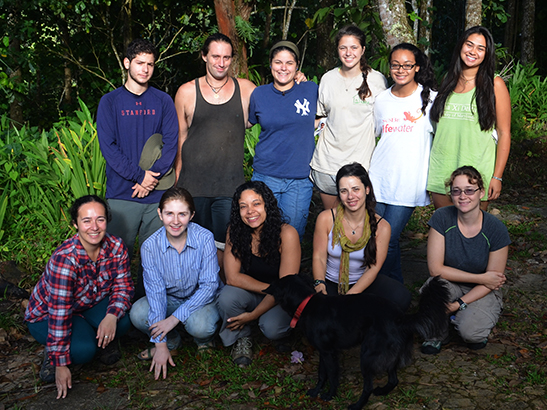
EARTHWATCH PARTICIPATION:
For several days of the survey, the team also comprised of three teenage Earthwatchers, Alana Salas-Yoshii, Josie Icaza, Samantha Riesberg, and their facilitator, Sushmita Sridhar.
Photo credits: Norman Greenhawk, 3t Vakil, Andrés Rúa, and Dr. Gabi Agostini (frog pix below).

For all those who partook in an Earthwatch expedition or any other volunteer escapade with myself, Thrity, Andres or Norman at Las Casas de la Selva and experienced the beauty of the project’s unique sewage system. I have good news!
I have written a book on the wonderful world of poo: “The Wastewater Gardener: Preserving the Planet One Flush at a Time” BUY IT HERE: https://wastewatergardener.com/
From the preface: “This book had its genesis the first time I tipped over an outhouse and shoveled the steaming contents into a wheelbarrow headed for the humanure compost heap. I was a city kid, I didn’t know the stuff was taboo. When I was selected to be a “biospherian” crew member for the first two year closure experiment of Biosphere 2, was it destiny that one of my responsibilities was managing our “marsh recycling system” for all the wastewater? Later, when I fell in love with wetlands, natural and constructed, I decided to make myself useful by tackling sewage problems around the world. That in turn, led me to one improbable adventure after another, a veritable Wonderland of strange goings on, at times straining my incredulity. Fortunately, I kept my inner yogas: keep your optimism and belief you can make a difference, and never lose your sense of humor!
It occurred to me these “adventures in the shit trade” have more than purely anecdotal humor value. I got to see what is hidden for good reason from most people, though sometimes it took persistence and detective work to find out what was really happening. I feel a responsibility to share what I have seen and learned with a greater audience. Everything is connected to everything (as they say in ecology), and how we manage and mismanage our shit, is a crucial part of the global challenge of our times. Conventional industrial-style agriculture doesn’t use animal manure = we turn our farms into monocultures, raise our animals in factory farms, use lots of chemical fertilizers which are expensive, release greenhouse gases and nutrients runoff our farms in great quantities polluting our waters and oceans. In the West, we centralize sewage treatment = sending all of its nutrients into our rivers and oceans, instead of back to our farms or green spaces. Rather than irrigating using gray water, we use precious high quality potable water. In poorer countries, there is virtually no effective sewage treatment at all = widespread contamination of drinking water leading to disease, death and further impoverishment.
We all know the story, “The Emperor has no Clothes”. This book is the global black comedy which unfolds when the little boy opens his eyes. I do hope you enjoy the ride. I promise it’ll change the way you think about at least one of the so-called “little things” we do in life.”
The book takes the reader on a humorous global tour of how we treat and mistreat human wastes. Even the common word for our bodily wastes: “sh*^#t” is taboo so we don’t talk about it and don’t think intelligently about how to use it properly. And our sewage is a global catastrophe. In the West we treat it like a toxic waste, spend enormous energy and resources to pump it to centralized sewage treatment plants where much machinery and chemicals are employed, then generally dump the treated wastewater with its load of freshwater and nutrients into the nearest body of water – rivers, lakes, ocean. In the developing world, 95% of sewage is untreated and pollutes drinking water everywhere.
So after a brief history of how we “got into this mess” with a review of traditional Asia where city “night soil” was a source of revenue as it was sold to boatmen who took it upriver to farmers who composted it, maintaining the fertility of the soils that produce the city’s food. Then came specialized farming so even animal wastes are now replaced by expensive chemical fertilizers, half of which run off the soils to pollute water. And for the cities, came indoor plumbing so that water use greatly increased, and flush toilets require up to 10 tons of water to move 1 ton of human waste.
But no need for despair, the paradigms are changing and there a number of alternatives which are gaining traction which offer a return to valuing and using bodily wastes as a source of valuable nutrients and water. These include composting toilets, constructed wetlands for wastewater treatment and reuse, hygienic use of sewage for agriculture and aquaponics, gray water irrigation. On the water conserving sides, there are low-water methods of farming – including drip irrigation – and utilization of wastewater which contains the natural nutrients needed for landscaping or gardening, instead of using potable water with chemical fertilizers.
I take the reader on my personal odyssey into the world of “poo power” – learning by doing.
First stop is Synergia Ranch near Santa Fe, New Mexico where a group of people found the Institute of Ecotechnics and take on reversing the desertification of this semi-arid once prosperous high grassland. A thousand trees are planted, I briefly become the “horseshit king of New Mexico” making hundreds of tons of compost from our farm animals and the 1200 horses at the nearby racetrack. Photographs contrast the stark landscape of the 1970s to the new rich oasis, with organic orchard and vegetable farm that was created.
After a stint in West Australia starting the tropical savannah project of the Institute, I return to the U.S. to help with the Biosphere 2 project – the world’s first artificial biosphere, covering 3 acres with rainforest, savannah, desert, coral reef ocean, Everglades marsh and 8 people and their farm enclosed in an air-tight structure. There is no “away” in Biosphere 2 – as in, we can “throw it away”; everything has to be recycled if the world is to sustain itself. I manage and research our constructed wetland which treats and recycles all our human, domestic animal and laboratory wastewater inside for two years. It’s a revelation and I appreciate that a system like this needs to be spread around on planet – and could be a way to get people connected to some of their basic realities – where their water comes from and where their wastes go. Constructed wetlands are a natural approach – mimicing the power of natural wetlands to serve as the planet’s kidneys – so sunlight, gravity, green plants and microbes are needed, not machinery, chemicals etc. They also can be scaled from serving an individual house to cities with tens of thousands of people. There are several which cover more than a thousand acres.
While completing a Ph.D. with the systems ecologists at the University of Florida’s Center for Wetlands, I design and build a couple of “Wastewater Gardens” along the Yucatan coast south of Cancun, Mexico (with the assistance in the early years of the Biosphere Foundation, later the Institute of Ecotechnics) and use it for my dissertation research. We make the systems beautiful with a wide diversity of fruit and flowering trees and shrubs, not just boring “reed beds”. The systems are popular – being “subsurface flow wetlands”, there is no exposed sewage, it’s all kept beneath a dry layer of gravel – and we pass the “sniff test”! Then lots of hotels and people want it for their homes – and we go into business!
This business, now called “Wastewater Gardens International” (www.wastewatergardens.com) takes me in the following decades around the world: Bali and Indonesia, the Bahamas, Western and Eastern Europe, the Caribbean, the Philippines and back to the outback in northwest West Australia, doing a number of Wastewater Garden projects on indigenous Aboriginal communities. The book takes people on a ground-truth, nitty-gritty ride of dealing with health system bureaucrats (“diaper phobia” or “nappy neurosis”), differing cultures and attitudes, Sherlock Holmesing the mysteries of what’s actually happening (e.g. wastewater waterfalls in the Atlas Mountains, 5 star resorts using unsterilized wastewater to grow lettuce (!), unsealed “septic tanks” etc.
Along the way, we have lots of examples of practical projects using a variety of new approaches, and photographs galore. New of the most recent projects are a crescent-moon shaped Wastewater Garden in southern Algeria and a proposed art/ecology project, Eden in Iraq (www.meridelrubenstein.com/eden-in-iraq/) for Marsh Arab towns in the historic Fertile Crescent area of southern Iraq.
I end the book with seven guidelines for better management of our wastes: 1. Separate shit from the water cycle wherever possible. 2. Use water of the appropriate quality, according to need 3. Conserve water – drip irrigation, low-water appliances 4. Use wastewater to create green belts 5. Treat and reuse shit locally wherever possible. 6. Don’t mix industrial waste with residential waste 7. Send the sludge and compost made from human shit back to the land in an economical way, maintaining the health and productivity of our soils
So the book is both a global black comedy and is filled with concrete examples at micro and macro-scale of how we can and are beginning to fix the problems.
The paradigms they are changin’ – appropriate in a world with scarce water resources and the desire of everyone to live in a bountiful and healthy biosphere.
…from the book’s ending:
“I would therefore like to add a Fecesphere meditation. Each time you go to the toilet to take a dump, be mindful of what you are doing. “Where does my water come from?” “Where does my shit go?” Then perhaps, investigate, find out. You will be way more connected to reality by trying this simple meditation and you’ll come to understand how life on this planet is indeed sustained. Then ask: “How can I make this activity healthier for my local ecosystem and indeed the biosphere?” “How can I change the world?”
The answer is not in the glorious, perfected hereafter (“there’ll be pie in the sky when you die”) but right now, beginning with understanding the “travel itinerary” of your shit. How do we change the world, help create the Earth we want and need? No action is trivial or unimportant.
We change the world one small step at a time, one flush at a time.”
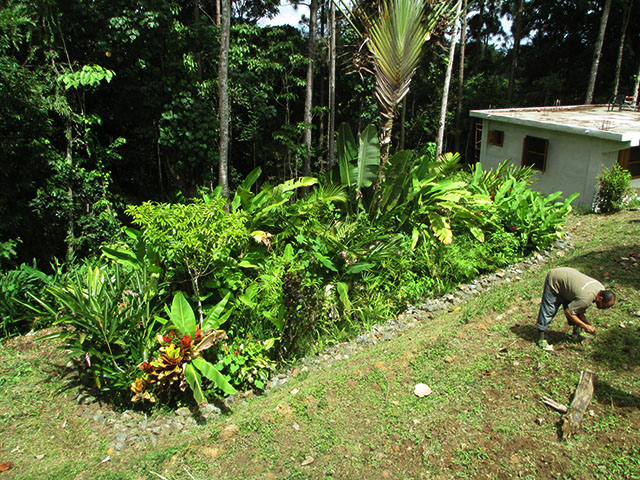
Here is the Wastewater Garden at Las Casas de la Selva…
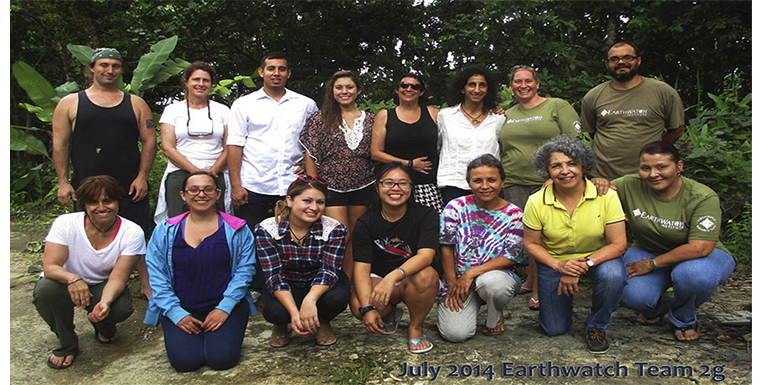
Thank you to all the Earthwatchers who fielded in our summer season. Through rain, mud, and slippery slopes, everyone made it over established comfort levels and discovered themselves anew at the end of each expedition. We are happy to have had Marta Edgar here as PI on the ongoing Bird Survey, and she worked with the first team. 3t continued on with tree data collection on the Liberation thinning study and also gathered, with team 2g, a complete monitoring of the endangered endemic tree species planted last year in a collaborative project with US Fish & Wildlife. Norman is carrying out a one month Herpetological survey in Icaco and Hormiga Valley and the teenagers on Team 3 along with their Earthwatch Facilitator, got to camp for 6 days and work on this study.
We really appreciate the level of enthusiasm brought to our project by volunteers, because without you, data would be hard to collect. We salute you all.
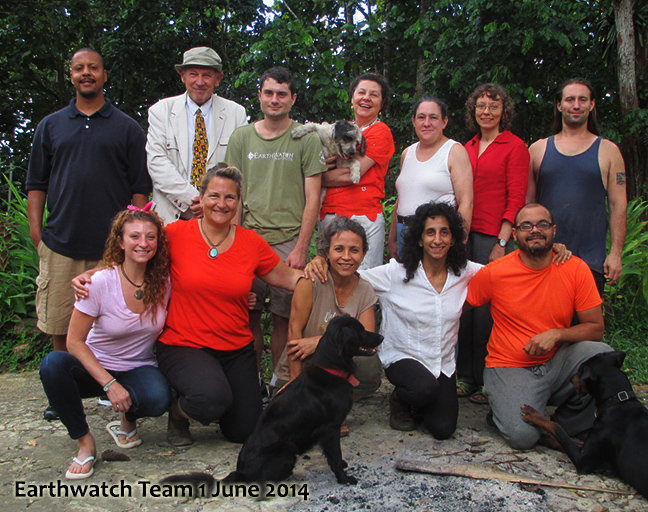
Back L-R: Khalil Brookins, Philip Sully, Michael Caslin, Lisa Oldham, Coralie Todd, Marta Edgar, Norman Greenhawk.
Front L-R: Vanessa Porcelli, Sonja Brown, Magha Garcia Medina, 3t Vakil, Andrés Rúa.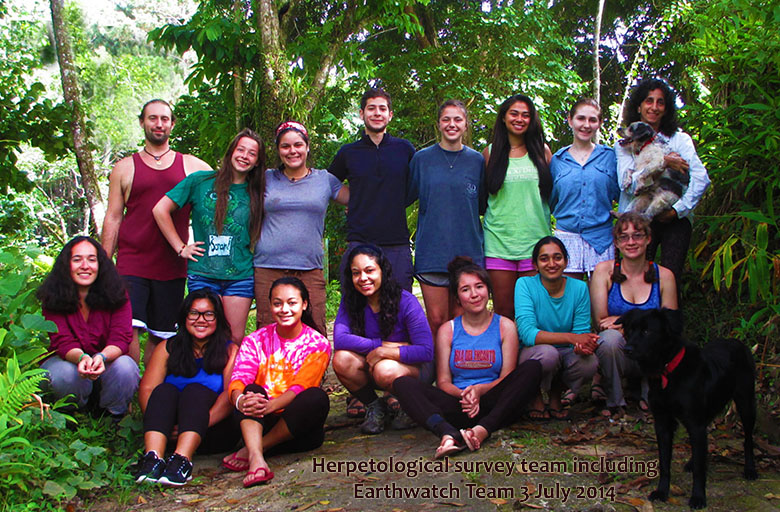
Front L-R: Victoria Overbey, Melissa Guardado, Brittany Concannon, Cheyanne Tran, Magha Garcia Medina, Sandra Martin, Marisa Gonzalez.
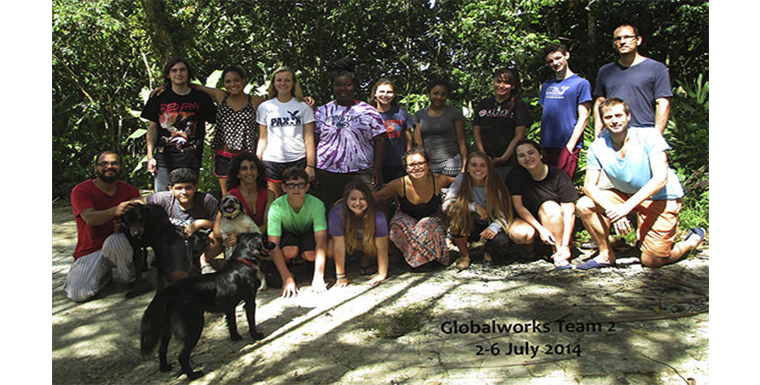
Thank you Globalworks, we appreciate all your hard work on the forest road, pruning, and working on drainage ditches. The help in the gardens was also great, clearing vines and digging the soil to loosen it all up.
For 23 years, Global Works has been providing exceptional Community Service, Cultural Exchange, Adventure Travel, and Language Immersion programs for teens, which foster personal growth and promote social and cultural awareness for the participant and the communities involved.
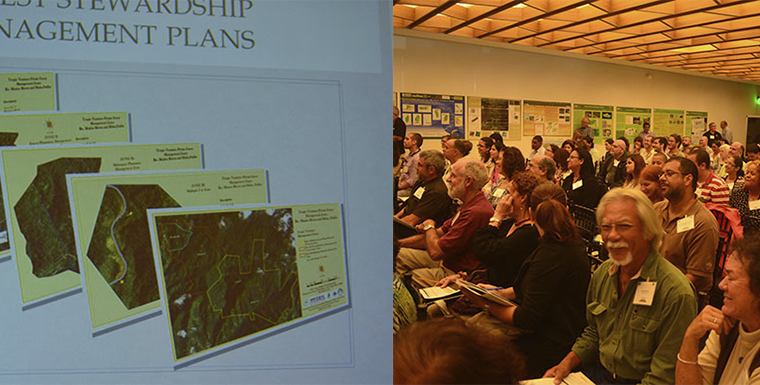
International Institute of Tropical Forestry celebrated its 75th year anniversary and a wonderful event at the Fundacion Luis Munoz Marin (FLMM) gave everyone a chance to meet up and connect over the whole days symposium, followed by a wonderful and lively reception in the evening. 21st May 2014
See more great images of this event here. Pix by 3t and Andrés
Tropic Ventures was honored to be mentioned in the recently published 2102 IITF Accomplishments. See PDF here.
Gracious thanks to FLMM, and IITF.

Another historic meeting for CADA, this time at Las Casas de la Selva, sustainable forestry project in the steep mountains of Patillas.
CADA, comprises of individuals brought together by a strong commitment to stimulate and create the sustainable management of all forest resources on the island of Puerto Rico. Founded in 2013 by Andrés and 3t.
SEE MORE IMAGES FROM THIS MEETING HERE:
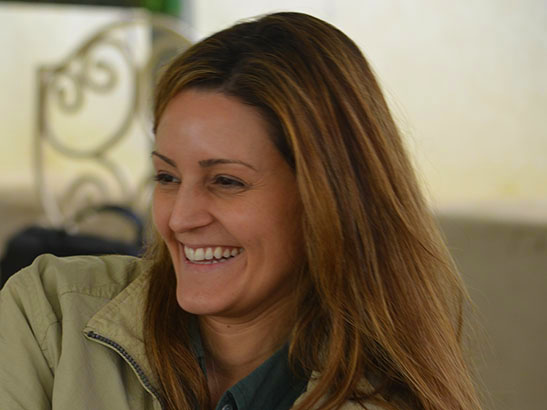
| Participants Name | Agency or group |
| Andrés Rúa González | Tropic Ventures Sustainable Forestry |
| Thrity Vakil | Tropic Ventures Sustainable Forestry |
| Magaly Figueroa (Vía teléfono) | USDA US Forest Service |
| Arnaldo Astacio | Departamento de Agricultura de Puerto Rico |
| Alexis Laurent Dragoni Cebollero | Consultor Fundación Aireko |
| Christina Cabrera | Departamento de Recursos Naturales y Ambientales de PR |
| Enrique Santiago | Departamento de Recursos Naturales y Ambientales de PR |
| Jess Zimmerman | UPR Rio Piedras |
| Franklin Román | Servicio de Extensión Agrícola |
| Jimena Forero | UPR Rio Piedras |
| Rosamaría Quiles | Departamento de Recursos Naturales y Ambientales de PR |
| Tomas Torres | Fundación Aireko |
| Orlando Gómez | Paddle Sur |
| Francisco Alicea | Municipio de Arroyo |
| Elizabeth Rodriguez | Voluntaria |
| Milagros Solís Ocasio | Pridco |
| Hector Rodriguez | Pridco |
| Evelyn Melo | Pridco |
| Omar Garcia | Paddle Sur |
| Enrique C. Colon Burgos | Autoridad de Energía Eléctrica |
SEE MORE IMAGES FROM THIS CADA MEETING AT LAS CASAS DE LA SELVA, 6TH MAY 2014
See images from the CADA meeting at Cyber Café, Caguas, 4th March 2014
See images from the CADA meeting at the International Institute of Tropical Forestry, 30th August 2013.
See images from the meeting of The Forest Products Assessment group, at Cayey University, the day the group formally became CADA, 6th May 2013
See images from the meeting of The Forest Products Assessment group at International Institute of Tropical Forestry, March 18th 2013.
See images from the FPA Field meeting at Las Casas de a Selva, 8th August, 2012
See images from the FPA Symposium at the Department of Natural Resources, Rio Piedras, 11th April, 2012
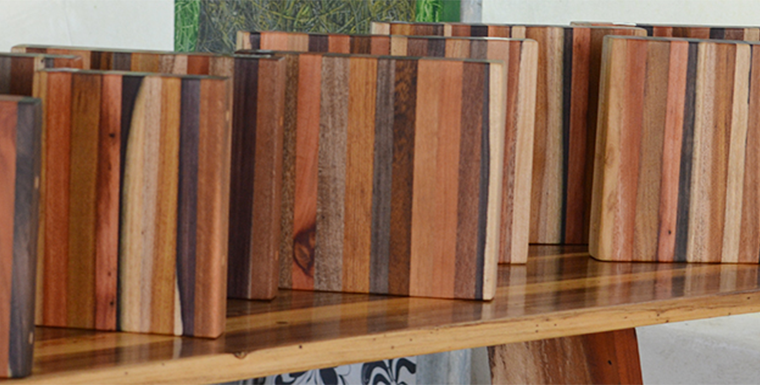
Boards By Andrés Rúa. Andrés Rúa has been super busy making his signature items, cheese and bread boards from a selection of Puerto Rican hardwoods.
Put on show this afternoon and nearly all, promptly sold!
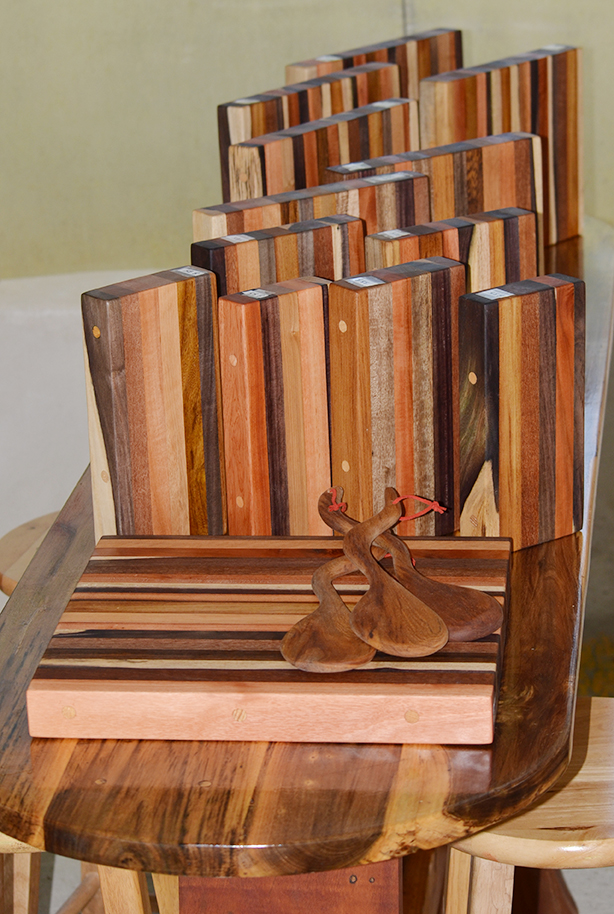
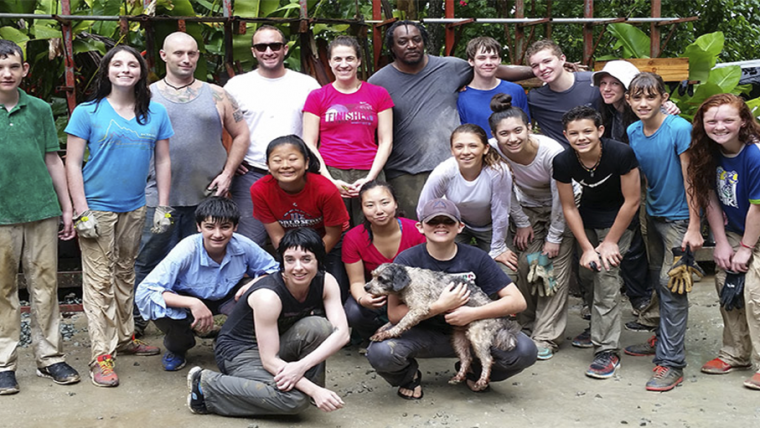
Globalworks along with Chris Corrigan and his staff, brought the whole 8th Grade of San Francisco Day School, CA, to Puerto Rico. The group split into three teams and each team spent two and a half days at Las Casas de la Selva, helping on a variety of physically demanding tasks, such as building a concrete wall-overhang, shoveling soil to replenish the organic gardens, hauling heavy rocks from the river to use as trail stabilizers, and pruning back overgrowth from trails. A super time with all the teams, 3t was chef and Andres and Norman were crew leaders. Thanks also to SFDS staff Michelle Phillips, Elise Holston, Steve Roberts, Marcella Anwandter and Loren Moye, San Fran Day School staff, and Globalworks leaders Chris Federer, Luiz Bertolo, and Scott Page.
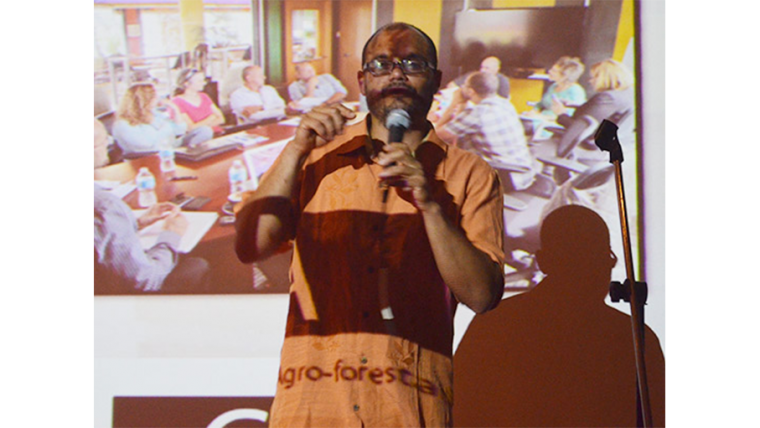
Andrés Rúa gave an inspiring talk about the status of the wood industry in Puerto Rico to students of the School of Fine Arts In Old San Juan on 23rd April 2014. More at www.nuestramadera.org
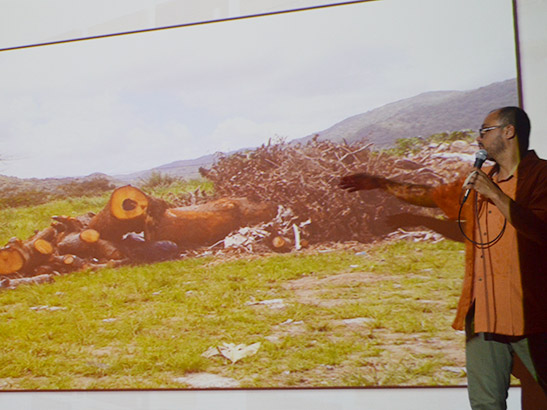
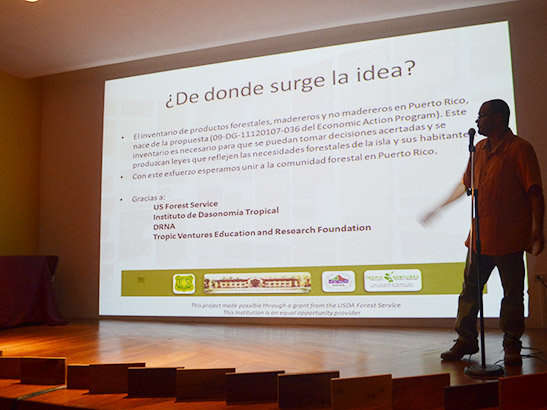
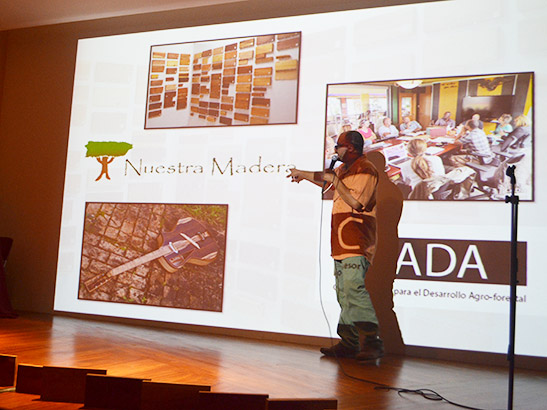
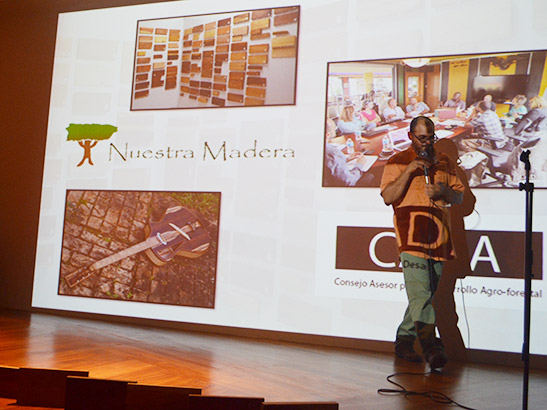
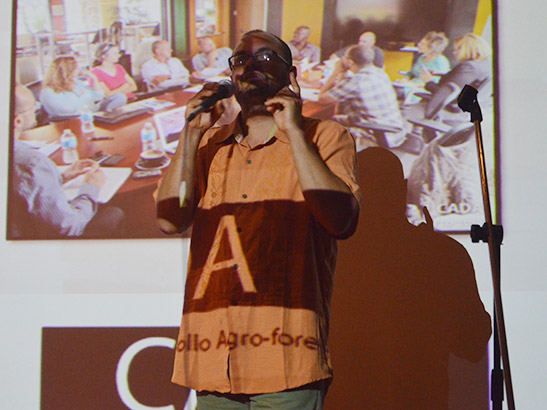
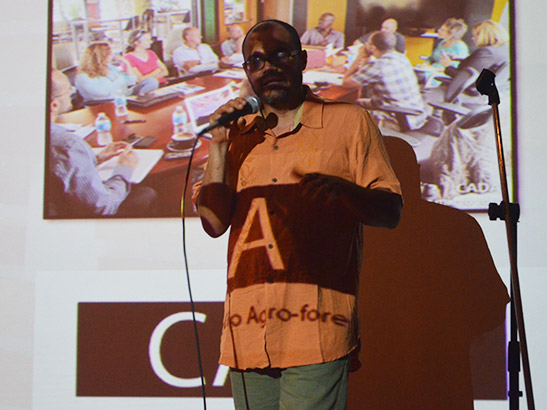


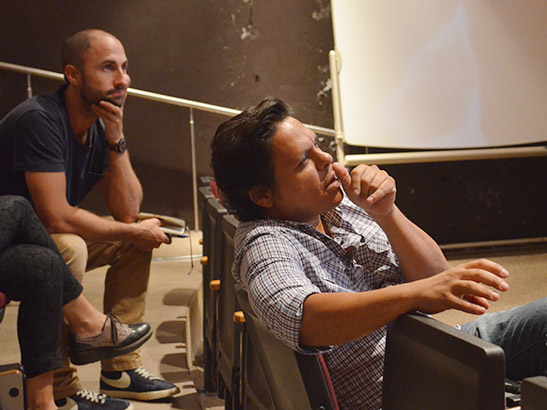
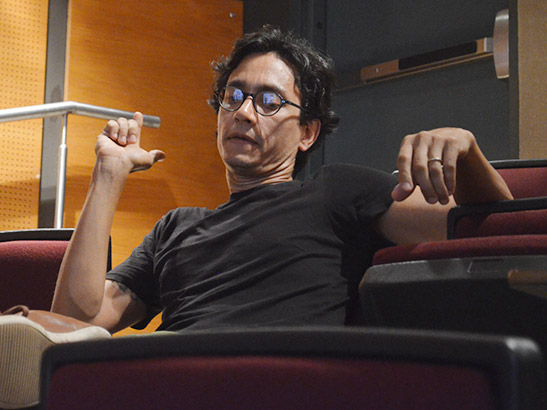
Marx Rosado, Professor of Industrial Design at the School of Fine Art. Marx is encouraging his students to use materials that are local and sustainable. 
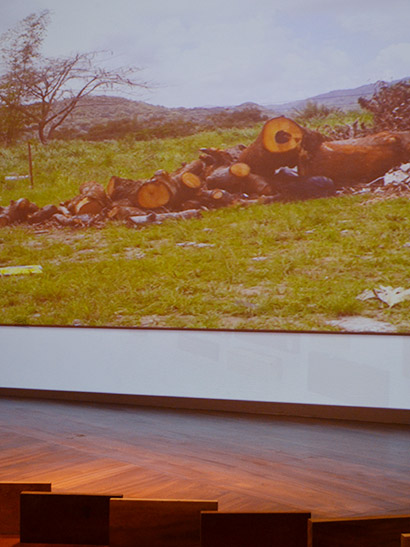
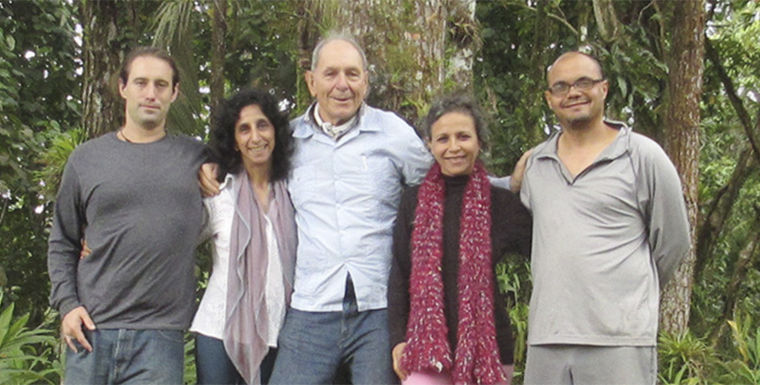
Johnny Dolphin, founder of Las Casas de la Selva, visited in early April and we also celebrated the 30th Anniversary of the project.
Here is a link to an album of images from Johnny’s stay.
L-R: Norman Greenhawk, 3t Vakil, Johnny Dolphin, Magha Garcia, Andrés Rúa
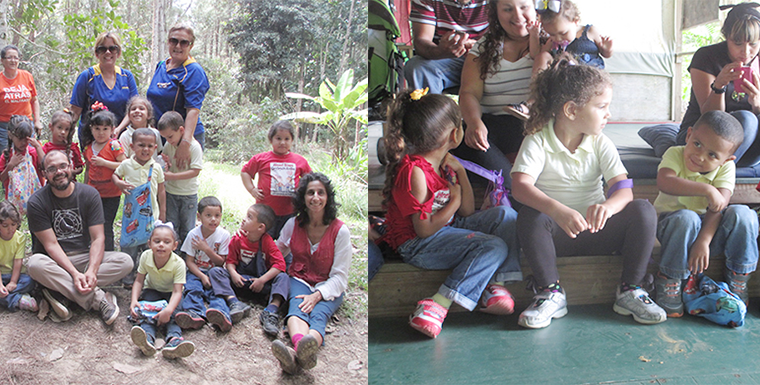
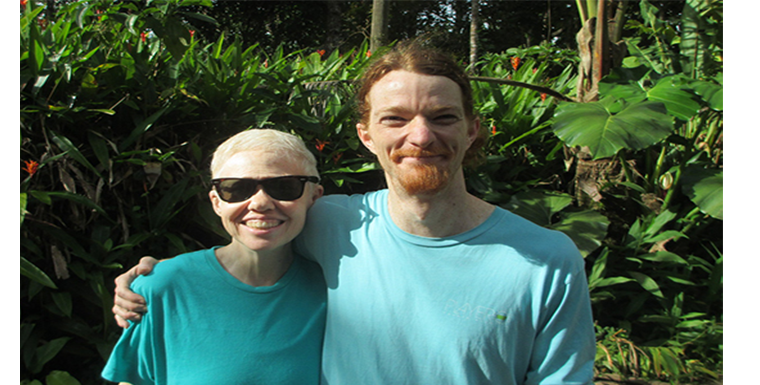
George LoCascio from Bunkerhill Community College in Boston, returned to spend a few days at Las Casas de la Selva, along with Denise O’Malley, helping out on gardens and continuing with George’s ongoing Lepidoptera project. This consists of a species survey and a population survey. The species survey involves the use of aerial mesh traps, that carry fruits as bait to attract butterflies,that remain unharmed for proper identification. Along with aerial traps traditional hand nets are used to capture species for identification. Both methods are used to compile a list of Lepidoptera species that are found on the property. The population survey is along a predetermined 1.1 km transect that can be, and is, repeated to find population trends of different known species. George and Denise also continued with a project begun last year, measuring the volumes of tree trunks and using the density of the wood to determine the amount of carbon dioxide that has been sequestered within them. George has been returning to Las Casas frequently over the last few years. This was Denise’s second trip here.
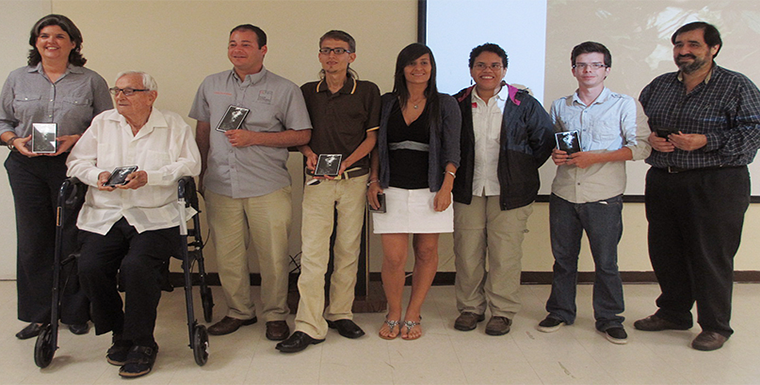
4to. Simposio de Educación, Interpretación e Investigación en Bosques y Áreas Naturales,
Viernes, 21 de marzo de 2014, Edificio de Agencias Ambientales, Rio Piedras.
Speakers:
Introduction and closing by Frank H. Wadsworth
Carmen Guerrero Pérez, Secretaria – DRNA
Dayamaris Candelario, Directora – Centro Ambiental Santa Ana (CASA)
Astrid Maldonado, Asistente de Proyecto – Para la Naturaleza
Pedro Rios, Forest Staff Officer – US Forest Service
Glorienell Pérez Vélez, INTER (Receinto de Bayamon)
Edgardo González González – DRNA
Eliezer Nieves, Ayudant Especial de la Oficina de la Secretaria -DRNA
Christian Torres, Director – Parque Doña Inés (FLMM)
Waldemar Feliciano Estudiante Subgraduado – INTER (Bayamon)
Julio Vallejo González, Coordinador de Alcance Comunitario – San Juan ULTRA
Gracias Yaritza Bobonis y Dayamaris Candelario y voluntaries por une dia muy interesante.
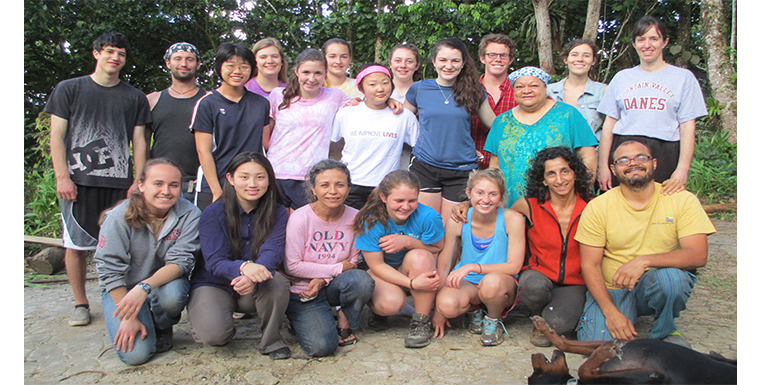
A team of Fountain Valley High School students from Colorado Springs, CO, spent five days with us. Led by Andrés and 3t, the students completely emptied out the entire woodworking and machine shop, cleaned and organized all the tools, cleaned machines, took out all the wood stockand re-organized it, and left the workshop clean, organized and far more user-friendly! Students also worked in the nurseries and trails with Norman. Thank you to Deb Prantl and Vydia Garcia for tremendous team leadership, and a super big thanks to all the students who carried out such an incredible task. We really appreciated your help, and also the constant smiles and endless enthusiasm.
Please come back in the future!
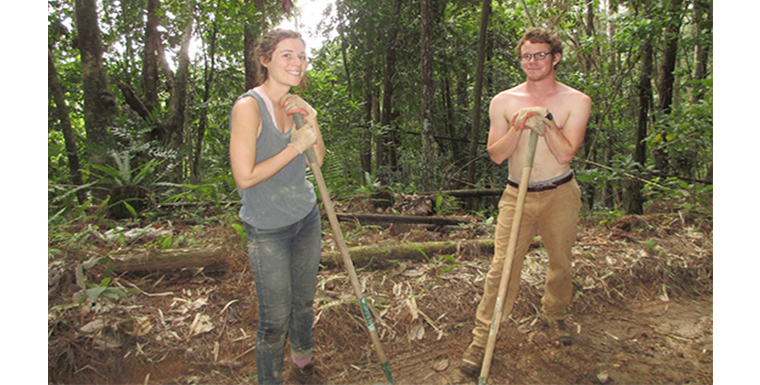
Genny and Tim, spent 10 days with us during the Appalachian State University group’s visit, and helped with all aspects of the project. We really appreciated their wonderful company, super hard work, and enthusiasm! They are off to spend more time at our sister project Synergia Ranch, Center for Innovation and Retreats, in Santa Fe, New Mexico. https://synergiaranch.com/about-us/



















